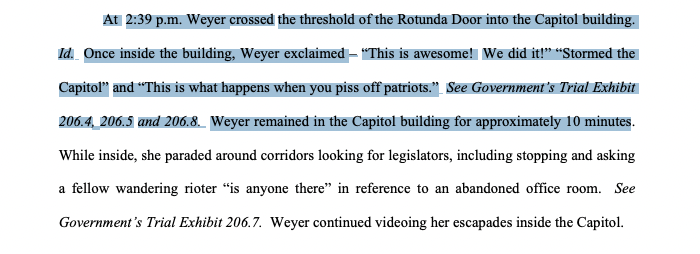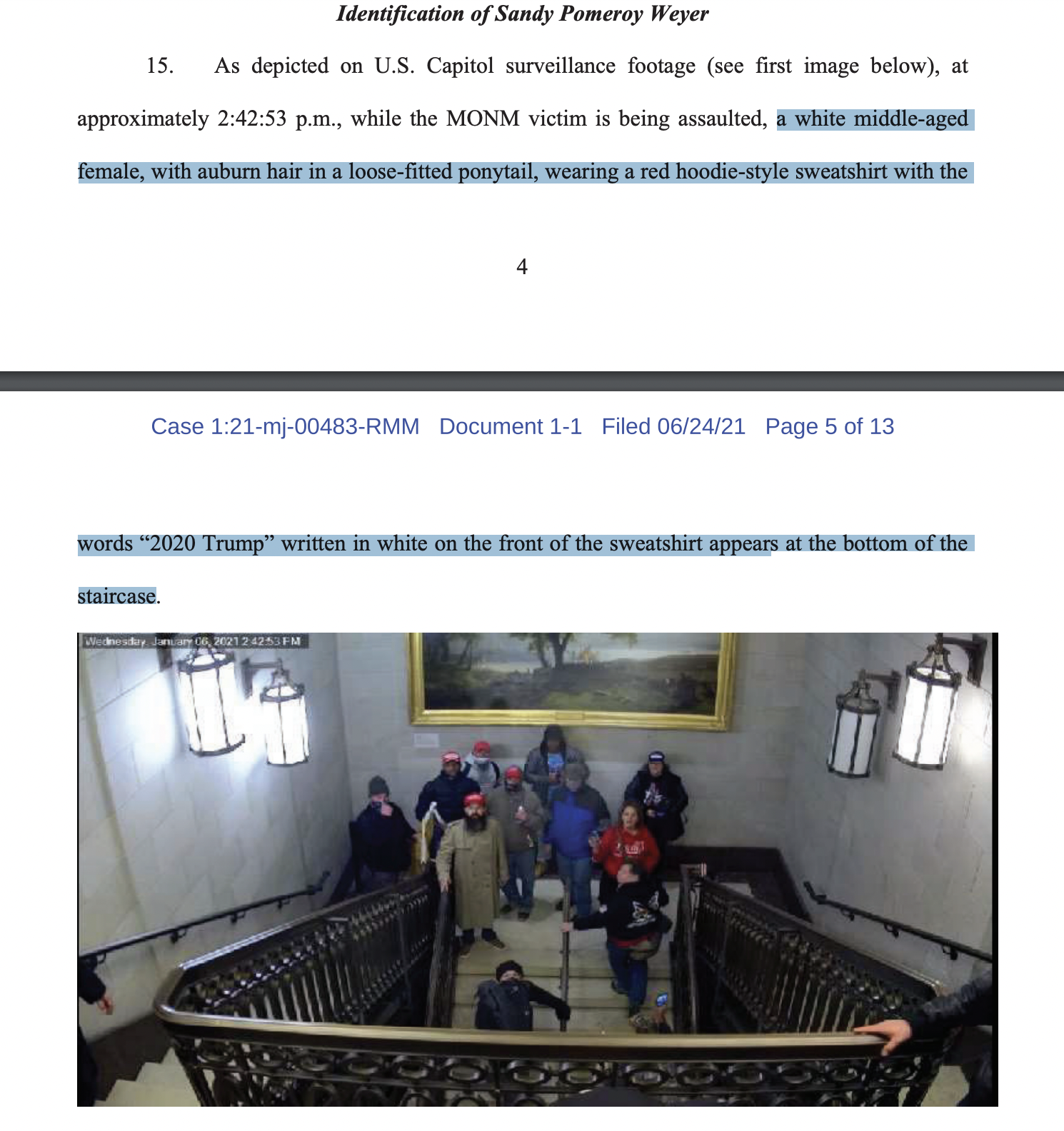Sandy Weyer, age 57 at the time, entered the Capitol on Jan. 6 on the East side of the building, the same side where Brandon Straka stood outside with his bullhorn and the same side where Dr. Simone Gold entered. Weyer went to the protest with her brother and two friends expecting to hear from "her favorite Senator" at the time, Sen. Mastriano, who had planned to speak at the protest rally in a permitted space on the East side. She had been an avid supporter of Mastriano and was once very close to him. According to Weyer, Mastriano never once stuck up for her publicly and, at one point, even denied he knew her.
Weyer had "no intention of harming anyone or obstructing Congress." She considered her actions to be "acts of civil disobedience." Like many others, Weyer documented the events of the day, streaming Facebook live as she entered through the Columbus Door, a pair of magnetic doors controlled from the inside. Protesters never breached the doors from the outside. Instead, it later became known that a protester opened the doors from the inside.
Weyer and her friends regrettably followed the crowd through the Columbus Door entrance. By the time she entered the building, she had lost her brother. As a result, she spent most of her time inside looking for him. She and her friends were inside the building for a total of 11 minutes. They left the Capitol grounds when they received an alert that a curfew was being imposed in D.C.
 Columbus Door/Sandy Weyer Case/https://www.courtlistener.com/docket/62651449/58/united-states-v-weyer/
Columbus Door/Sandy Weyer Case/https://www.courtlistener.com/docket/62651449/58/united-states-v-weyer/
Weyer told UncoverDC she couldn't really pinpoint why she entered.
"Maybe it was curiosity or just following the crowd. But the doors opened, and, yes, there were a few Capitol Police standing at the top of the stairs, but they didn't say anything to us. At some point, they pepper-sprayed us and set off a couple of flash bangs, but after the doors were opened, people were going in and out. There was no more pepper spray or flash bangs, no megaphone. They weren't saying to leave the Capitol or anything like that."
As she was standing in the crowd behind the bike racks that had been set up as barriers, Weyer admits to chanting things like "stop the steal," "let us in," "tear it down," and "break that door." She also told viewers on her livestream that she was "storming the Capitol."
 https://www.courtlistener.com/docket/62651449/58/united-states-v-weyer/
https://www.courtlistener.com/docket/62651449/58/united-states-v-weyer/
Court documents state Weyer helped take down bike racks, pushed her way past police, and assisted the Proud Boys and Oath Keepers. The government used that information to convict Weyer. However, during her bench trial, the government, according to Weyer, "never showed any evidence of me doing those things."
Weyer does, however, acknowledge her inflammatory rhetoric. Her actions and words are documented in her court docket and Facebook live video. The video footage disproves several key aspects of the government's case.
Confusion Inside the Capitol
Within minutes of entering the building, Weyer heard screams inside. She followed the screaming, running to the top of a stairwell where she "caught the tail-end of someone getting off the ground, somebody screaming."

Weyer Complaint
At that point, Weyer says, "The word in the crowd was it was Antifa or BLM dressed as a Trump supporter. I live-streamed the interaction between two men dressed in all black from head to toe with black backpacks and masks on their faces. I found out much later that it was supposedly a New York Times reporter they knocked down and took her cameras. But I only heard her yelling at them. She looked like the aggressor to me at the time. So I yelled, 'Get the F out. You're a traitor.'"
After the fact, says Weyer, the clip of her yelling at the woman was all over the media. "When I was arrested, it was all over the news on CNN and MSNBC. Colbert "even did a skit on it." Oddly, the incident with the alleged reporter was mentioned in Weyer's complaint, but it was never once mentioned in court. To her knowledge, Weyer says the two men have never been identified.
"The media said I participated in the brutal attack on the reporter. But I never laid hands on anybody. I was never charged for any of it. They never even brought it up in my trial, which my attorney and I thought was strange. It wasn't even brought up in the sentencing memorandum. Later, I heard she was held at gunpoint by the Capitol Police because she didn't have her identification on her and was later released."
Government Ignores Exculpatory Evidence
Weyer explained that lawyers for the government said in their opening statement that they would "prove Sandy Weyer went to the Capitol looking for legislators." She couldn't believe her ears when she heard their opening:
"I'm sitting there thinking, OK, I wanna see this. I wanna see this proof that you have because that never happened. I never mentioned a legislator. I never mentioned looking for anybody other than my brother. And when there was no proof, there was no repercussion for the prosecution when it lied. The judge didn't reprimand them and say, 'Wait a minute, where's this proof that you said you were going to show that she was in there looking for legislators? Because the only thing that you've shown is that she was looking for her brother.'"
Weyer also shared that she had in evidence an email from Homeland Security to the FBI agent who testified against her. The government, she said, "went through my social media and found no evidence I was going to stop the certification of the election. They had no evidence of anything other than I was going to support President Trump and Senator Mastriano."
When Weyer's attorney addressed the FBI agent on the stand with the proof of her intentions, the FBI agent said he "didn't agree with it." Weyer's attorneys reiterated the facts detailed in the email and asked the agent to show proof. The FBI agent had nothing. According to Weyer, the judge never reprimanded the prosecuting attorneys. Weyer's attorneys told her, "It happens all the time. This is what the prosecution does," and they want to "make you look bad."
Weyer's sentencing memorandum indicates she was hellbent on obstructing Congress:
"Weyer was an active part of a large mass of rioters using their combined mass and extreme force and violence to breach the Capitol to prevent the peaceful transition of power. Her words, taken in the context of her actions that day, invalidate any notion that Weyer breached the Capitol merely to engage in peaceful political commentary, as do her statements upon exiting the Capitol."
Weyer refused to take a plea deal because, in her mind, she didn't go to the Capitol to harm others, destroy property, or to get in the way of "official proceedings." The government recommended 30 months. However, on Sept. 14, Judge Boasberg sentenced her to 14 months for a felony (1512(c)(2) and 2 or Obstruction of Proceedings, Aid and Abet) with one year of supervised probation and $2000 in restitution by Judge Boasberg. Under Section 1512(c), a defendant can be sentenced to a term of up to 20 years in prison plus a fine. The DOJ has improperly used the charge repeatedly in J6 cases.
Weyer believes the government formulated its sentencing recommendations by emphasizing her activism during COVID and after the 2020 election. She believes the government ultimately punished her for her activism, even though it acknowledges the activities were "lawful."
The government states Weyer is "politically sophisticated...participated in lawful protests and understood the legal avenues available to protest the election results with which she disagreed." The government also alleges her "disorderly conduct" between 1982 and 1983. According to the government, Weyer's charges were related to her having "screamed obscenities at law enforcement."
The sentencing memorandum proves the government used her activism during the pandemic and her conduct in the early 80s to prove Weyer "consciously decided to act illegally" out of "frustration at a political outcome." The 30-month sentence recommendation was based on Weyer's actions on Jan. 6, "her attempts to justify her actions," and her "prior criminal conduct."
As with many J6 cases, deterrence is a common rationale behind handing out longer sentences. The government states in Weyer's case, "The nature of the instant offense, including her attempts to justify her actions, coupled with her prior criminal conduct, increases the likelihood that she will not ameliorate her behavior absent a lengthy sentence."
The Aftermath
There is not one J6 defendant with whom UncoverDC has spoken who thinks they were an angel on Jan. 6. Bombastic rhetoric and high emotion that led to poor behavior seem to be a common thread among defendants. While a small minority of those present, many defendants still damaged property or engaged in violent altercations with law enforcement. However, none of the people interviewed thus far has said there should be zero consequences for their behavior.
Sadly, the government continues to frame behavior to justify undeserved, harsh sentences. Juries and judges in D.C. seem to be primed to deliver a guilty verdict regardless of the evidence presented. There is little doubt the entire system in D.C. now operates within a framework that is politically biased. Even judges who intend to be fair are presented with information that paints all J6 defendants as terrorists and insurrectionists. There is very little evidence the Americans who attended J6 plotted to overthrow the government.
The documentary 79 Minutes documents the initial breaches of the Capitol and asks important questions about the government's preparedness for an event it almost certainly knew in advance that thousands, if not millions, would attend. The film adds important context and is one everyone should watch. Stephen Horn, the journalist who narrates the documentary, was present on Jan. 6. He has been charged with four misdemeanors and will be sentenced in January. Journalists are usually protected from First Amendment activity related to their reporting of events, but not on Jan. 6. Several journalists have been rounded up and indicted.
Reading the vicious notes Weyer and other J6 defendants have received online and in their mailboxes is alarming. Some of the messages she has received are pictured in the gallery below. Thankfully, colleagues, family, and friends also submitted 60 pages of supportive notes to the court vouching for her character.
[gallery type="slideshow" size="medium" td_select_gallery_slide="slide" td_gallery_title_input="Notes to Sandy Weyer" ids="55943,55944,55945,55946,55947"]
J6 defendants suffer in ways that go well beyond the effects of a weaponized justice system. It is common and typical for J6 defendants to be doxxed, harassed, and viciously threatened by fellow Americans. In many cases, Americans do not take the time to examine the facts of the J6 cases. So many Americans fail to grasp the profoundly human stories unfolding in the wake of Jan. 6.


